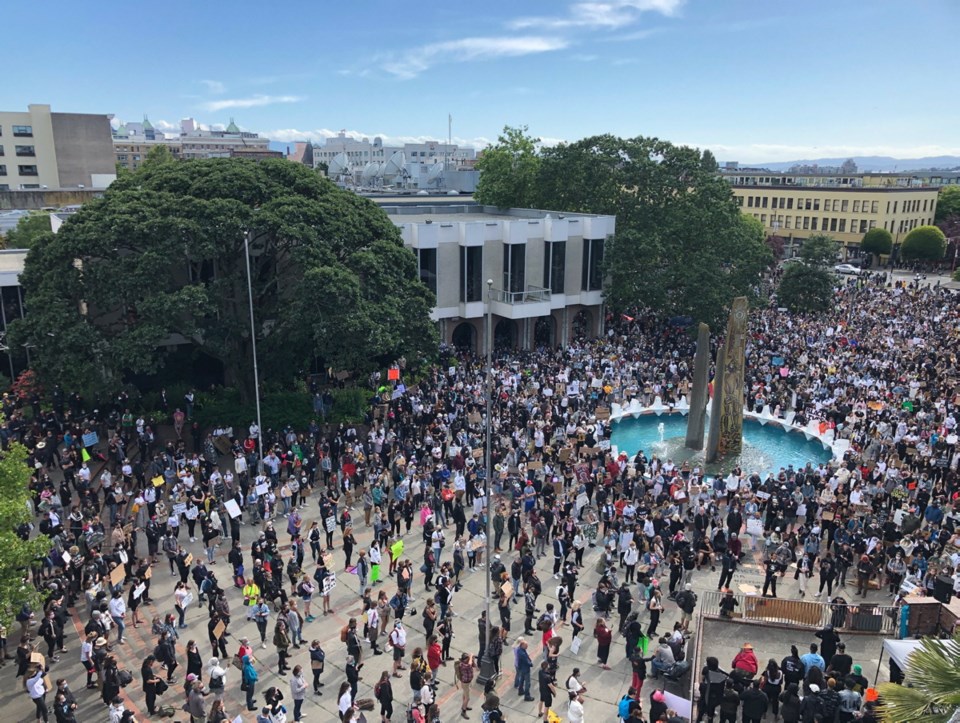A test of “first-rate intelligence,” wrote F. Scott Fitzgerald, is “the ability to hold two opposed ideas in mind at the same time and still retain the ability to function.”
If this is true, then anti-racism protests in the midst of still-ongoing pandemic are an IQ test on a mass scale, in Canada and around the world. Stay home to fight the COVID-19 virus; come out on the street to fight racism — what is a conscientious citizen to do?
Prime Minister Justin Trudeau finds himself at the centre of this IQ test — facing questions on Monday about how he reconciled his participation in a huge rally on Parliament Hill last week with months of dispensing advice about the need for physical distancing.
The powerful symbolism of Trudeau taking a knee in Friday’s protest also became quickly symbolic of the contradiction at the juncture of the two biggest stories in the news right now.
“People are upset and confused,” federal Conservative Leader Andrew Scheer said, “to see the prime minister completely ignore those types of health guidelines or recommendations.”
Trudeau, for his part, says it was a question of balancing priorities, offering a small glimpse into the calculated risk-taking he did last Friday.
“To look out the windows of my office and see thousands upon thousands of young people, of Canadians of all ages stand in solidarity, to wanting to see change happen, I felt it was important for me to be part of that,” Trudeau said.
He said he tried to follow physical distance rules, “wearing a mask, keeping distance where possible. But I recognize that it is a difficult situation where we are trying to balance very important competing interests.”
Public health officials are being somewhat more blunt about the risk — not just for the prime minister, but for anyone who has made the decision to burst out of COVID isolation and plunge into the hordes of street protesters. They should be monitoring symptoms and maybe even getting tested, chief public health officer Dr. Theresa Tam said on Monday.
“There is some risk; that’s the reality,” deputy health officer Howard Njoo said at a briefing in Ottawa. Given that the COVID-19 disease generally takes five or six days to incubate, Njoo and Tam said that public health officers would be intently watching the numbers over the coming days to see any spike in cases.
The same thing will be happening in the U.S., where the protests have been more massive and widespread.
Dr. Anthony Fauci, top health adviser to Donald Trump in the early days of the lockdown, has been much more low-profile in recent weeks, especially since the death of George Floyd lit the fuse on demonstrations across the U.S.
But in the past few days, Fauci talked to the Sunday Times of London and described how the pandemic-protest contradiction looks to him.
“As I sat in front of the TV and watched the screen go from Washington, D.C., to New York City, to Los Angeles, to Philadelphia, I got really concerned,” Fauci told the Sunday Times. “I was going: ‘Oh my goodness. I hope this doesn’t set us back a lot.’ ”
While the medical scientists will be looking for any connection between the protests and the pandemic, so will the social scientists.
It is noteworthy how people quickly found so many ways to replace their normal activities during the lockdown with virtual substitutes: Shopping online or using Zoom to hold meetings, social gatherings, church services — even Parliament.
But virtual protests weren’t going to cut it after Floyd died in police custody in Minneapolis two weeks ago.
We’ve been hearing for months now that when things started reopening after the lockdown, there would be this thing called “pent-up demand.” As it turns out, the largest expression of this frustrated demand hasn’t been economic, but sociological. People didn’t pour into the streets to shop, but to lodge their outrage against long-simmering social injustice.
On this issue, there is no contradiction between the pandemic and the protests — both have awoken people’s sense of powerlessness and frustration, as well as a recognition that the lockdown has exposed the weakest links in our economy and society.
Worse, it’s increasingly apparent there’s no quick fix for either the pandemic or the systemic racism that has tipped off the risky protests. Frustration is widespread and simmering.
These are the threads that connect the pandemic and the protests — which may not require “first-rate intelligence” to reconcile, but certainly some appreciation for the larger, not-so-opposite forces acting on citizens in these current, crazy times.
Susan Delacourt is a columnist for the Toronto Star.



